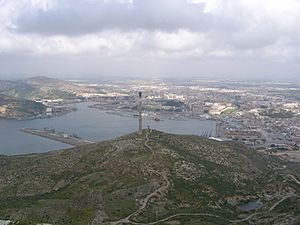Cartagena uprising facts for kids
Quick facts for kids Cartagena uprising |
|||||||
|---|---|---|---|---|---|---|---|
| Part of the Spanish Civil War | |||||||
 Cartagena |
|||||||
|
|||||||
| Belligerents | |||||||
|
|
|||||||
| Commanders and leaders | |||||||
| Strength | |||||||
| One brigade three cruisers eight destroyers |
Cartagena's garrison two auxiliary cruisers |
||||||
| Casualties and losses | |||||||
| 61 dead | Cartagena's garrison 1 transport ship sunk 1,225 dead and 700 prisoners |
||||||
The Cartagena uprising was a short but important event during the final days of the Spanish Civil War. It happened in the city of Cartagena from March 4 to 7, 1939. During this revolt, a large transport ship called SS Castillo de Olite was sunk. This uprising showed how divided the Republican side was near the end of the war.
Contents
Why Did the Uprising Happen?
By early 1939, the Spanish Republic was in a very difficult situation. Its army had lost many soldiers. Important areas like Catalonia, with its factories, were now controlled by the other side.
A Hopeless Situation for the Republic
On February 27, 1939, the president of the Republic, Manuel Azaña, resigned. Also, major countries like the United Kingdom and France recognized the government of Francisco Franco, the leader of the Nationalist side.
Divisions Among Republicans
Many top Republican army leaders believed that continuing the war was impossible. However, the prime minister, supported by the Communist Party of Spain (PCE), wanted to keep fighting. This disagreement led to a big split.
The Plan to Take Control
Colonel Segismundo Casado and other important figures decided to act. They planned a coup d'etat (a sudden takeover of government) against the prime minister. Casado had support from:
- Generals Matallana and Miaja
- The CNT (a workers' union)
- The Republic's secret service (SIM)
- Parts of the Spanish Socialist Workers' Party (PSOE) and the UGT
What Happened During the Uprising?
The uprising began when the Republican government tried to put a new commander in charge of the naval base in Cartagena.
A New Commander Arrives
On March 3, Juan Negrin, the prime minister, appointed Francisco Galán to lead the naval base in Cartagena. Galán was a member of the Communist Party. He arrived on March 4 to take command.
The Revolt Begins
However, supporters of Colonel Casado, led by Colonel Gerardo Armentia, revolted. They arrested Galán. Then, a group called the Fifth Column (people secretly helping the enemy) in Cartagena joined the rebellion. This group was led by Colonel Arturo Espa.
They quickly took control of important places:
- The coastal batteries (big guns near the sea) called Los Dolores.
- The city's radio station. From here, they broadcast messages asking the Nationalists for help.
A retired general named Rafael Barrionuevo declared himself the military governor of the city.
The Republican Fleet Flees
On March 5, Nationalist planes bombed Cartagena's harbor. They sank a Republican destroyer ship called Sánchez Barcáiztegui. Because of this attack, Commander Miguel Buiza made a big decision. He ordered most of the Republican fleet to leave Cartagena.
The fleet included:
- Three cruisers: Miguel de Cervantes, Libertad, and Mendez Nuñez.
- Eight destroyers.
They sailed away from Cartagena and headed to Bizerte, a port in North Africa.
The Uprising is Crushed
Francisco Galán, who had been freed by the rebels, escaped on board the Libertad cruiser. Meanwhile, the IV Division of the Republican Army, led by a communist officer named Joaquim Rodríguez, was sent to Cartagena. Their mission was to stop the rebellion.
On March 7, the 206th brigade arrived in Cartagena. They quickly crushed the uprising. They took back control of the radio station and the coastal batteries. Sadly, 61 people died during this fighting.
The Sinking of the Castillo de Olite
While the fighting was happening, Franco, the Nationalist leader, had sent troops to support the rebels in Cartagena. Two Nationalist transport ships arrived. They did not know that the rebellion had already been crushed.
The shore batteries in Cartagena, now back under Republican control, fired at one of these ships, the SS Castillo de Olite. The ship was sunk at close range. A terrible number of soldiers died: 1,225 were killed, and 700 were taken prisoner.
What Happened Next?
Even though the uprising was stopped, the Republican fleet did not return to Cartagena. Instead, it stayed in Bizerte.
The French authorities in Bizerte took control of the ships. Later, they handed them over to the Nationalists. Without their fleet, it became impossible for the Republicans to evacuate many people who wanted to escape Spain. This meant many Republican supporters were left behind.
See also
 In Spanish: Sublevación de Cartagena (1939) para niños
In Spanish: Sublevación de Cartagena (1939) para niños
- List of Spanish Republican military equipment of the Spanish Civil War
- List of Spanish Nationalist military equipment of the Spanish Civil War

